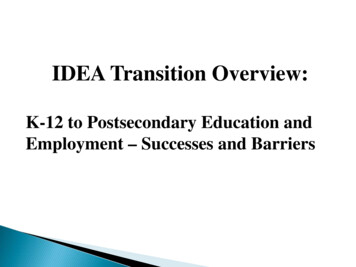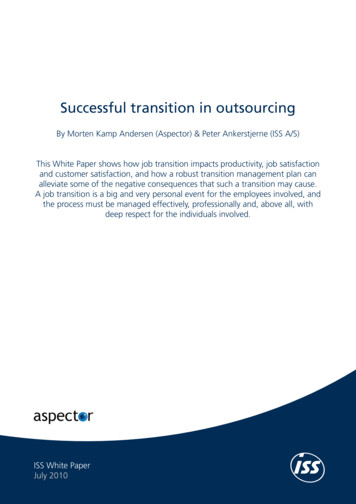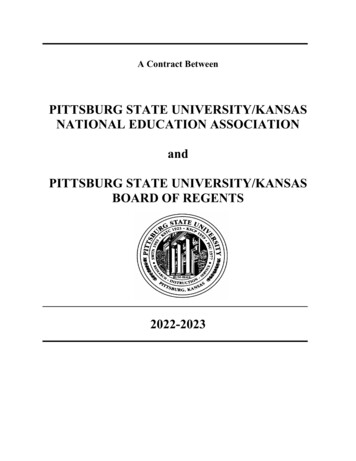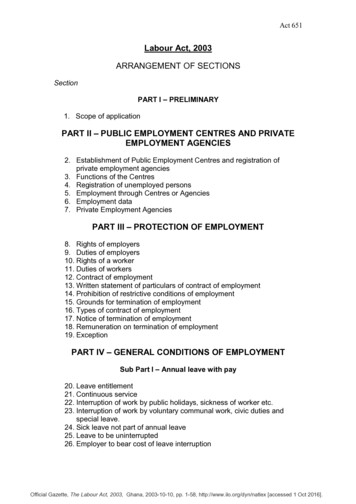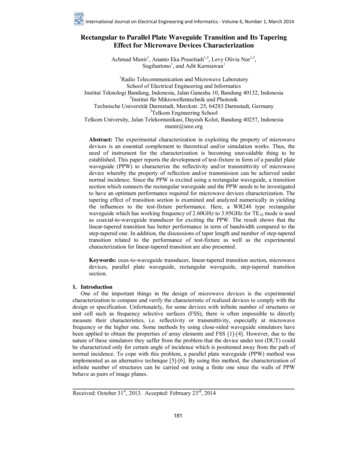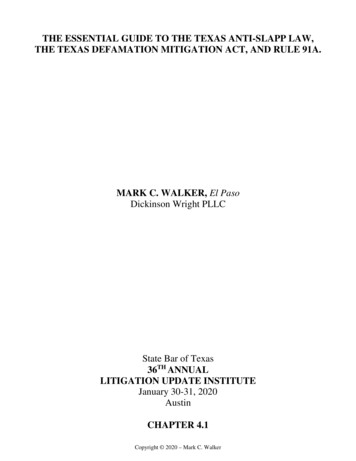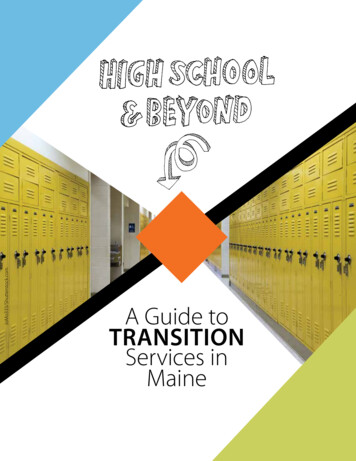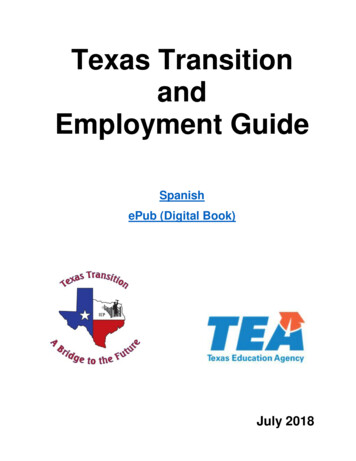
Transcription
Texas TransitionandEmployment GuideSpanishePub (Digital Book)July 2018
Sections of Transition and Employment GuideABOUT THIS GUIDE3SELF-ADVOCACY, PERSON-DIRECTED PLANNING, AND SELF-DETERMINATION4456INTRODUCTIONTIMELINEWHO CAN HELPTRANSITION SERVICESINTRODUCTIONTIMELINEWHO CAN HELPEMPLOYMENT AND SUPPORTED EMPLOYMENT SERVICESINTRODUCTIONTIMELINEWHO CAN HELPSOCIAL SECURITY PROGRAMSINTRODUCTIONTIMELINEWHO CAN HELPCOMMUNITY AND LONG-TERM SERVICES AND SUPPORTSINTRODUCTIONTIMELINEWHO CAN HELPPOSTSECONDARY EDUCATIONAL PROGRAMS AND SERVICESINTRODUCTIONTIMELINEWHO CAN HELPINFORMATION SHARING WITH HEALTH AND HUMAN SERVICES AGENCIES ANDPROVIDERSINTRODUCTIONTIMELINEWHO CAN HELPGUARDIANSHIP AND ALTERNATIVES TO GUARDIANSHIPINTRODUCTIONTIMELINEWHO CAN 41414344CONTACT INFORMATION FOR ALL RELEVANT STATE AGENCIES45TEXAS TRANSITION AND EMPLOYMENT GUIDE DEFINITIONS46FEDERAL AND STATE LAWS51TRANSITION IN TEXAS TIMELINE542
ABOUT THIS GUIDEThis transition and employment guide is for you, the student in Texas public school, who may havereceived special education services due to a disability. It also provides helpful information for yourparents. This guide has steps you and your parents can take to make sure you are able to find theright work or educational choices for you after high school. It also tells you where to get theservices you will need after high school.The guide is divided into sections on Self Advocacy, Transition Services, Employment andSupported Employment, Social Security Programs, Community and Long Term Services andSupports, Postsecondary Educational Programs and Services, Information Sharing, andGuardianship and Alternatives. Each section has phone numbers, emails, and websites to help youfind what you need. At the end of each section and at the end of the guide, you will find a timelineof steps that you and your parents can take as you make the transition from student to adult. If youhave questions about this guide or the information in it, please send us an email atsped@tea.state.tx.us.Copyright NoticeThese materials are copyrighted by and are the property of Education Service Center, Region11 and the Texas Education Agency and may not be reproduced, distributed or modifiedwithout their written permission except by Texas public school educators under the followingconditions:1. any portion reproduced or distributed will be used exclusively for nonprofit educationalpurposes in Texas and2. no monetary charge is made for the reproduced materials, any documents containingthem, or any activity at which they are distributed; however, a reasonable charge tocover only the cost of reproduction and distribution may be charged.To obtain a license to reprint large quantities, or to use the materials in a manner not specifiedabove, contact cjohnson@esc11.net3
SELF-ADVOCACY, PERSON-DIRECTED PLANNING, AND SELF-DETERMINATIONINTRODUCTIONTransition is the term used for the time when you are changing from a student to an adult. You,your parents, others that know you well, and your school begin to plan for transition while you arestill a student.Your parents and the school need to understand your wants and needs to make sure they areincluded in your plan. You need to talk to your parents and your teachers about how you canbecome more involved in making decisions about your educational program and your plans forthe future.When you turn 18, the law considers you an adult who has the rights and responsibilities of everyother adult. You can still ask your parents, or others that you know well for help to make importantdecisions, or voluntarily enter into a supported decision-making agreement with a supporter orhelper to make important decisions. Before graduating from high school, you and your parentsneed to talk about many things. Some of these things are getting a job, going to college, andwhere to live. You can take a bigger part in making decisions for yourself by: Getting training on how to make decisions on your own behalflearning how to speak up for yourselflearning how to set goalsworking on steps to reach your goalsmaking choices as a young adultspeaking up in your meetingshelping to plan your futureThis first section of the Texas Transition and Employment Guide talks about three ways for you tobegin to plan for the future.Self-Advocacy—Speaking for YourselfSelf-advocacy means speaking up for yourself. You should ask for what you need and want whenmaking decisions about school, work or where you want to live.Knowing yourself is your first step toward being a self-advocate. This means: talking about your needs, interests, likes, and dislikesknowing what you are good at and how you learnknowing what you want to doknowing what you have to dounderstanding your disability and how it affects your ability to work, learn, and livethinking about what you need to work, learn, and livelearning your rights, responsibilities, and how to get helptelling people what you need and wantasking for helpasking questions when you do not understand somethingspeaking up in your admission, review, and dismissal (ARD) committee and other planningmeetingshelping to write your individualized education program (IEP)4
Self Determination—Choosing for Yourself/Making Your Own ChoicesSelf-determination skills help you know yourself, your goals, and supports you need to reach yourgoals. You have the ability to learn and benefit from making your own choices.Making your own choices means: making decisions on how a supporter or helper can help youtaking responsibility for the decisions you makesetting goalslearning independent living, risk-taking, and safety skillsbelieving in yourself and your abilitiessolving problemsspeaking up for yourselfunderstanding what you know how to do and what you need to learndirecting or leading your own lifePerson-Directed PlanningYou can begin to make your own choices about things that affect your life. Person-directedplanning gives you the power to direct the supports and services that meet your needs. You andthe people who know and care about you work together to make life choices.Person-directed planning is a process that allows you and the legally authorized representative(LAR) on your side, to direct the development of a plan of supports and services that meets yourpersonal outcomes. The process must: identify existing supports and services necessary to achieve your outcomesidentify natural supports available to you and work out service system supports you willneedoccur with the support of a group of people chosen by you and the LAR on your sideaccommodate your style of communication and preferences regarding time and setting forthe planning meetingSupported Decision-MakingThere is a new law requiring an agreement when an adult with a disability needs help whenmaking decisions. You may voluntarily enter into a supported decision-making agreement with asupporter or helper. Supported decision-making is a process where you can ask another adultwho you know and trust, for example a family member, friend, or a community member to helpyou understand the situations and choices you have to face.Your supporter CANNOT make decisions for you. Your supporter CAN: Help you understand your choices and decisions Help you get and understand information to help you make your decisions Help you tell your decisions to other people With supported decision-making, you make your own choices with help. This lets you bemore independent.TIMELINEWhen or before you turn 14:5 Ask for or get training on how to make decisions.Practice speaking up for yourself.Understand and explain your disability and what you may need to do to learn more.Talk about your interests, wants, and needs.
Decide what you like to do, and what you are good at doingParticipate in your ARD committee meeting.When or before you turn 16: Ask if your transition plan includes training on how to make decisions,along with supportand services that may help you while in high school and after high school.Talk about your goals for life after high school.Practice how to act in different places (school, jobs, and so on).Identify heath care needs and providers (doctors, therapists, pharmacies) to meet yourneeds.When or before you turn 18: Voluntarily enter into a supported decision-making agreement with a supporter, or helperif needed.Plan for working, voting, further education, and signing up for services.Decide where you want to live and how you will do it.Ask for help, say what you need, and tell people that you know how to make decisions.Be on time for classes, appointments, social activities, and work.Ask about other services like health, employment, counseling, technology, and housingthat you can receive after high school.Accept responsibility for health care needs (make doctor or therapy appointments, fill andtake your prescriptions, etc.).After graduation: Take over making choices for your life.Find people who are willing to help you.Get help from a supporter or helper that you trust.Be open to trying positive new things.WHO CAN HELP Local SchoolYour school district has a transition and employment designee (TED) to help you and yourparents with information about being able to make life choices for yourself. You can findinformation about your school’s TED at:http://framework.esc18.net/display/W ebforms/ESC18FW CountyInformation.aspx?ID Transition Local ResourcesYou and your parents need to look at what is available in your community. This could be localadvocacy groups, offices of state agencies, or support groups. Texas Transition Network Contacts – Transition in Texas The transition specialist at your area’s education service center (ESC) can give you and yourparents information about planning for your future. A list of transition experts can be found at:http://www.transitionintexas.org/Page/7 AskTEDAskTED is an online list of Texas schools, including charters. Use this directory to find contactinformation for districts, schools, and education service px6
Texas School District Foster Care LiaisonEach school district/charter school in Texas has to have at least one person to help a studentwho is in foster care enroll in or transfer to a school. A list of the foster care advisers for yourschool can be found cess/liaisons/ Transition Planning Guide for Students in Foster Care Receiving Special EducationServicesThis guide clarifies the similarities and differences in the transition planning processes in thechild welfare and special education et.aspx?id 51539614471 Disability Rights TexasDisability Rights Texas is the federally designated legal protection and advocacy agency(P&A) for people with disabilities in Texas. You can contact the local office for help at:http://www.disabilityrightstx.org/ Institute for Person-Centered PracticesThe Institute for Person-Centered Practices helps you as a young adult learn how to take overyour life as much as you can. It works with the Texas Center for Disability Studies at theUniversity of Texas at Austin and the Center on Disability and Development at Texas A&MUniversity. For training and materials about person-centered practices, see:http://www.person-centered-practices.org/ National Technical Assistance Center on Transition (NTACT)NTACT is a website for teachers and agencies to learn about helping students get ready foreducation and work. Texas Council for Developmental Disabilities (TCDD)TCDD gives money to organizations to help people with developmental disabilities live on theirown. For a description of projects supported by TCDD see:http://www.tcdd.texas.gov/Find information about using respectful language at the following rst-language/ Department of Family and Protective Services/Child Protective Services (DFPS/CPS)DFPS/CPS maintains a youth-focused website for services and referrals for youth and youngpeople currently in foster care and those young people seeking transitional services fromfoster care to adulthood. In addition, DFPS, in collaboration with the Texas W orkforceCommission and the Casey Foundation, supports Transition Centers that provide an array ofservices, including education and vocational opportunities, employment readiness, housing,mentoring, and self-advocacy for youth and young people currently in foster care.See more information at:https://www.dfps.state.tx.us/About DFPS/default.asp Texas Project First, a project of the Texas Education Agency by and for familiesTexas Project First (Family to Family) provides information and resources for educators,school districts, parents, students, and the general public, including information on:o Self-Determinationo Person Centered Planningo Guardianshipo Self-Advocacywww.texasprojectfirst.org7
The Arc of TexasThe Arc of Texas can tell you how to find training and services to teach you and your familyhow to advocate for yourself. Learn about Project MOVE advocacy training and support at thefollowing pagename advocacy index Partners Resource NetworkPartners Resource Network (PRN) is a non-profit agency that operates the Parent Trainingand Information Centers (PTIs) in all areas of the state. Texas PTIs provide training,education, information, referral, emotional support, and individual help to get services. Getmore information at:www.prntexas.orgToll-free number: 800-866-4726 Texas Parent to Parent (TxP2P)TxP2P provides peer support and information to families of children with special needs and/ordisabilities. For detailed transition information see this link:http://www.txp2p.org/parents/pathway.html or call 866-896-6001(email cynda.green@txp2p.org).TxP2P also provides an on-line resource directory organized by counties. Just enter or selectyour county or a nearby county to see what resources are available for you or your family l Texas AdvocatesTexas Advocates provides training to its members on self-advocacy, self-determination,person-directed planning, and self-advocacy organizations at the following link:http://www.txadvocates.orgPlease send additional thoughts and comments to sped@tea.state.tx.us8
TRANSITION SERVICESINTRODUCTIONPreparing for the future is a part of everyone’s education. You, your parents, others that know youwell, and your school work together to build a roadmap to your future after you complete highschool. Developing this roadmap is called transition planning. You and your future are the focusof transition planning. Your interests, wants, and needs are considered in creating the plan foryour life.Transition planning helps you find out about your: ability to learn to make choicesinterestsskills and abilitiesskill development areas to be completed during high school in order to meet post highschool goalstransition needs, including independent living needscareer goalseducation choices for after high school graduation Both the United States (Federal) and Texas have laws for transition planning. The timelines forstarting transition planning are different under the two laws. This section has information aboutthe laws that apply to transition planning.In Texas, your admission, review, and dismissal (ARD) committee must have a transitiondiscussion by your 14th birthday. Transition planning may begin even earlier if your ARDcommittee decides it is right for you. By age 16, your ARD committee must write goals for your lifeafter high school. This is your transition plan. These goals are based on any further training oreducation you will need, work you want to do, and independent living skills you will need after yougraduate. It is important for you to take an active role in setting the goals. You and your parentsmust be invited to all ARD committee meetings, and it is important for you to attend andparticipate in the ARD committee meetings when transition is discussed.US (Federal) Requirements:34 Code of Federal Regulation (CFR) §300.43 Transition servicesTransition services are activities that are designed just for you that: Help you move from the activities you do in school to activities you want to do after highschool, such as:education or vocational training after graduationjobs and work (including supported employment)continuing and adult education (non-credit courses, work development programscustomized training)services you may need as an adultliving on your ownthings to do in your community9
Are based on your needs and on your strengths, preferences, and interests. Transitionservices may include:instruction (what is taught in school)related services (occupational therapy, physical therapy, speech therapy, andtransportation, if needed)community experiencesemployment or post-school adult living objectiveslearning independent living skillshaving a functional vocational evaluationWorkforce Innovation and Opportunity Act (WIOA)WIOA is a new law to improve access to education and workforce services for individuals withsignificant barriers to employment. This includes veterans, individuals with disabilities, out-ofschool and at-risk youth, and other populations to help ensure that everyone has an opportunityto get a good job.Recent amendments to the Rehabilitation Act authorize the Vocational Rehabilitation (VR)agency, along with your school, to provide or arrange for the early provision of pre-employmentservices for all students with disabilities who are eligible, or potentially eligible, for VR services.Pre-Employment Transition Services (Pre-ETS) - 5 Required Activity Areas: Career Exploration - counseling and guidance to to help you look at different careerareas, what those careers require, what someone doing that job does day-to-day, interestinventories, and other simple assessments to get a sense of what is a good career fit foryouWork-based learning – helps you explore careers in real work settingsCounseling on post-secondary opportunities - counseling and guidance for you onwhat post-secondary programs are available, what each requires, cost, and help withunderstanding financial aid, registration, and accessing accommodationsJob Readiness Training, including social skills training- any training/information thathelps you acquire a skill related to work. For example, soft skills, social skills,transportation, resume writing, interviewingSelf-Advocacy - any specific training/information that helps you gain self-advocacy skills CFR §300.320 Definition of individualized education program [Excerpt]Transition services must begin by the time you turn 16, or younger if the ARD committee decidesit is appropriate. This must be done every year.Your IEP must include appropriate measurable goals for after high school that are based on ageappropriate transition assessments for training, education, employment, and, whereappropriate, independent living skillsthe transition services (including courses of study) needed to help you reach those goalsTransfer of Rights at Age of MajorityBeginning no later than one year before you reach the age of majority under State law (18), yourIEP must include a statement that you have been informed of your rights, if any, that will transferto you when you reach the age of majority.10
Transition Programs for Students Aged 19-22If you have graduated by completing your IEP, or if you have not yet graduated but have not hadyour 22nd birthday, you could be eligible for continuing special education, vocational, andtransition services through your local district. Please contact your school district’s transition andemployment designee (TED) for information. You can find information about your school’s TED at:http://framework.esc18.net/display/W ebforms/ESC18FW CountyInformation.aspx?ID TransitionCFR §300.321 IEP Team The school must invite you to attend your ARD meeting if a purpose of the meeting willbe to consider goals for after high school and the transition services needed to helpyou reach those goals.If you do not attend the ARD meeting, the school must take other steps to makesure that your preferences and interests are considered.To the extent appropriate, with the consent of your parents or yourself if you havereached the age of majority (18), the school must invite a representative of anyparticipating agency that is likely to be responsible for providing or paying fortransition services to the ARD meeting.Texas State Requirements:Texas Administrative Code (TAC) § 89.1055. Content of the Individualized EducationProgram (IEP) [Excerpt]By age 14, your ARD committee must consider and, if appropriate, address any of these that areright for you: how involved you will be in your transition to life after high schoolif you are younger than 18, how your parents will be involved in your transition planningif you are least 18, how your parents or others that you know and trust will be involved inyour transition if they are invited to participate in your ARD committee meetingany post-school education preparation and choicesif you need a functional vocational evaluationwork goals and objectiveseducational preparation and choices available for you once you turn 18 to get ready forcollege, training, work, or independent livinglearning independent living skillsconnecting you and your parents to agencies and services, and if needed, assisting with areferral to an agency to place you on a waitlist such as a waiver programtraining to make decisions on your own behalf to help you prepare for adulthood so youhave the option of a supported decision-maker or helper, if needed.Texas Education Code (TEC) §29.0111. Beginning of Transition PlanningBy the time you are 14, state transition planning must begin.TIMELINEWhen or before you turn 14:11 Ask for or get training on how to make decisions for yourselfTalk to your parents and teachers before attending ARD committee meetingsExplain your interests, needs, and strengths.Participate in the ARD committee meeting discussions about transition services.
Speak up about what you need at school.Speak up about what you want to happen after high school.Make sure you get information about all choices during ARD committee meetings.Learn about agencies outside of school who might provide you with any services.Parents: If your child is identified with a developmental disability, put his or her name on aninterest list until services are available, you can find more information about the interest list tics/interest-list-reduction. Please know that it maytake years.When or before you turn 16: Ask if your transition plan includes training on how to make decisions, along with supportand services that may help you while in high school and after high school.Check your transition plan at least once a year until you graduate from high school.Write goals for after you graduate from high school.Give permission to share information with people you know and trust outside of schoolwho might help you with transition services.When or before you turn 18: When you turn 17, you should ask for and receive notice about what rights you will havewhen you become an adult.Ask for and receive your adult rights. Your parents will continue to get notice of your ARDcommittee meetings, but can only attend the meetings if you or the school invites them.Voluntarily enter into a supported decision-making agreement with a supporter, or helperif needed.Give permission to share information with people you know and trust outside of school.Give permission to parents or others you know well and trust to participate in a supporteddecision making agreement.After graduation: Get a written list of what you have done in high school (diploma, transcripts, summary ofperformance, etc.).Ask for and receive notice that your high school education is completed.WHO CAN HELP Local SchoolYour school district has a transition and employment designee (TED) to help you and yourparents with information about transition services. You can find information about yourschool’s TED at:http://framework.esc18.net/display/W ebforms/ESC18FW CountyInformation.aspx?ID Transition Local ResourcesYou and your parents need to look at what is available in your community. This could be localadvocacy groups, offices of state agencies, or support groups. Texas Transition Network Contacts – Transition in TexasThe transition specialist at your area’s education service center (ESC) can give you andyour parents information about planning for your future. A list of transition specialistscan be found at:http://www.transitionintexas.org/Page/712
Texas Special Education Information Center (SPEDTex)Provides information and resources to stakeholders across the state of Texas. Specialists areavailable by phone at 1-855-SPED-TEX (1-855-773-3839) or email at inquire@spedtex.orgwww.spedtex.org AskTEDAskTED is an online list of Texas schools, including charters. Use this directory to find contactinformation for districts, schools, and education service px Texas OncourseTexas Oncourse is an online website that has college and career resource information to helpyou plan for college and work.https://texasoncourse.org/about/ Texas CTE Resource CenterTexas CTE is an online website that gives you information on different career choices.https://www.txcte.org/teachers Texas School District Foster Care LiaisonEach school district/charter school in Texas has to have at least one person to help a studentwho is in foster care enroll in or transfer to a school. A list showing the foster care liaison foryour school is posted cess/liaisons/Transition Planning Guide for Students in Foster Care Receiving Special Education Services Transition Planning Guide for Students in Foster Care Receiving Special EducationServicesThis guide clarifies the similarities and differences in the transition planning processes in thechild welfare and special education et.aspx?id 51539614471 Department of Family and Protective Services/Child Protective Services (DFPS/CPS)DFPS/CPS maintains a youth-focused website for services and referrals for youth andyoung people currently in foster care and those young people seeking transitionalservices from foster care to adulthood. In addition, DFPS, in collaboration with theTexas W orkforce Commission and the Casey Foundation, supports Transition Centersthat provide an array of services, including education and vocational opportunities,employment readiness, housing, mentoring, and self-advocacy for youth and youngpeople currently in foster care. More information is available at:https://www.dfps.state.tx.us/ DFPS Transition Living ServicesTransition Living Services lists many programs, information, and resources abouttransition for foster youth and alumni ages 14-23 years. More information can be foundat:https://www.dfps.state.tx.us/Child Protection/Youth and Young Adults/default.asp Navigate Life TexasThis website is especially for families and parents of children with disabilities or specialhealth-care needs. It is designed to offer support, inspiration, resources, and links to g/en13
Partners Resource NetworkPartners Resource Network (PRN) is a non-profit agency that operates the Parent Trainingand Information Centers (PTIs) in all areas of the state. Texas PTIs provide training,education, information, referral, emotional support, and individual help to get services. Getmore information at:www.prntexas.orgToll-free number: 800-866-4726 Preparation for Adult Living (PAL)The PAL program prepares the foster youth for the inevitable departure from the care ofDFPS. The foster youth are provided skills and resources they will need to be healthy,productive, and independent adults. More information can be found at:https://www.dfps.state.tx.us/Child Protection/Youth and Young Adults/Preparation For Adult Living/default.asp Children with Special Health Carer Needs (CSHCN) Services ProgramMedical assistance programs and promotes family-centered, community-based, culturallycompetent, coordinated health care, and family sipport shtm Texas Parent to Parent (TxP2P)TxP2P provides peer support and information to families of children with special needs and/ordisabilities. For detailed transition information see this link:https://www.txp2p.org/ or call 1-866-896-6001 (email cynda.green@txp2p.org)TxP2P also provides an on-line Resource Directory organized by counties. Just enter orselect your county or a surrounding county to see what resources are available for you oryour family l Transition CentersThese centers help connect foster youth with services, including educational support, food,housing, employment, health care, counseling and more. More information can be found local/Please send additional thoughts and comments to sped@tea.state.tx.us14
EMPLOYMENT AND SUPPORTED EMPLOYMENT SERVICESINTRODUCTIONTexas Workforce Commission (TWC) -TW C has services that help you find and keep good jobs.TW C helps employers hire skilled workers they need to grow their businesses. W orkforce partnersinclude community colleges, adult basic education providers, local school districts, economicdevelopment groups, businesses, and other state agencies. TWC offices have the followingemployment services: registration with WorkInTexas.com--TWC’s online job matching systemreferrals to job listingsinformation about high demand jobs in your areas (labor market)evaluation/assessmen
goals. You have the ability to learn and benefit from making your own choices. Making your own choices means: making decisions on how a supporter or helper can help you taking responsibility for the decisions you make setting goals learning independent living, risk-taking, and safety skills

